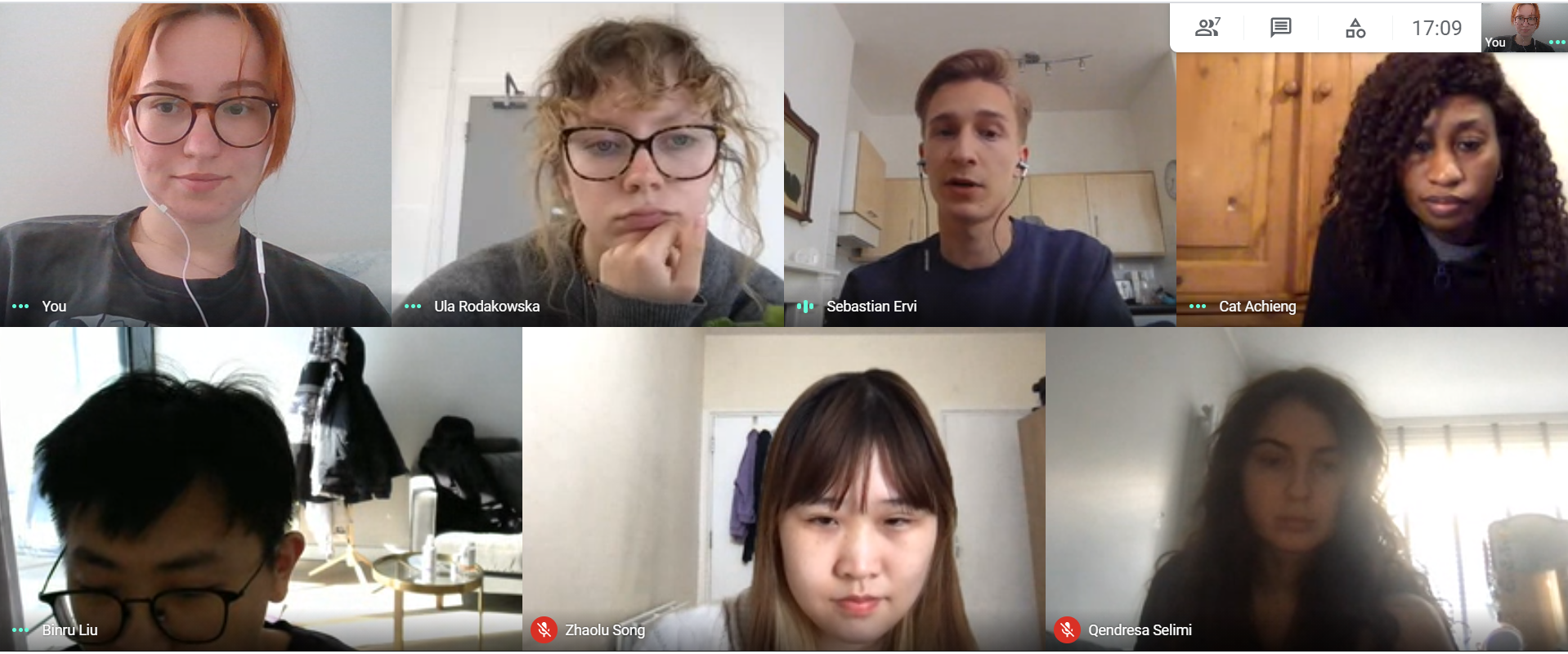22nd April - 29th April
Partner Company: Bittersuite
Brief: Re-design the acoustic properties of a physical space
Group: Ula Rodakowska, Sebastian Ervi, Zhaolu Song, Qendresa Selimi,
Cat Achieng, Binru Liu, Kate Chernysheva
Partner Company: Bittersuite
Brief: Re-design the acoustic properties of a physical space
Group: Ula Rodakowska, Sebastian Ervi, Zhaolu Song, Qendresa Selimi,
Cat Achieng, Binru Liu, Kate Chernysheva
This term MA:UX collaborated with 4 companies: Chelsea Physic Garden, This Ain’t Rock’n’Roll, Robochef and Bittersuite. Before the allocation I was very excited to see the new briefs. After completing Macro UX, where we worked for 6 weeks on one brief I felt the need to see something new and refreshing. Finally, I was allocated to work with Bittersuite, which specialises in creating multi-sensory experiences inspired by music. Due to my rich musical background I was very excited to be exploring this creative field from the perspective of User Experience Design.

Sensory Score performance by Bittersuite. Photo taken from CrystalZillwood.co.uk
INTRODUCTORY WORKSHOP
Before the introductory workshop I decided to prepare myself and do some initial research about Bittersuite. I really enjoyed exploring their work and would have really liked to experience it myself. However, due to COVID-19 it wasn’t possible. While my research provided me with some basic information about the company, I didn’t have anything to go off as at this point we still haven’t received the brief, which was sent to us minutes before the presentations started. Hence, I felt a little underprepared at the welcome presentation as we were put on the spot to ask Steph (our partner from Bittersuite) some questions. Nevertheless, we had a very productive time chatting to Steph. She told us more about Bittersuite, what she does, what the brief is like etc. Even though the brief seemed to be very hard and confusing to all of us we felt very excited to get started. It was also great to finally meet everyone in person.

My group for this project (from left to right): Sebastian, Qendresa, Zhaolu, Cat, Binru and Ula. Photo by Kate.


Bittersuite presentation and post-presentation discussion. Photos by Kate.
PRELIMINARY RESEARCH
To start off, we all began researching different topics, such as senses, acoustics, the physics of sound, waves, vibrations, etc. We each wanted to take some time to understand the brief and think about how we want to proceed with the project.
I decided to look into how acoustics work, sound and the physics side of things.
Acoustic space - when we 'receive auditory signals from all directions all at once' (Findlay-White and Logan, 2016). However, in modern age, they also cite McLuhan to describe it as 'the conveyance of electric information via telegraph, telephone, radio, television, and would certainly have added, and indeed embraced, the digital age that he so presciently foresaw.
Sound - energy that can be trasmitted by longitudinal pressure waves in a material medium (such as air) and is the objective cause of hearing (Merriam-webster.com, 2021).

Image to show the definition of sound. Taken from an online source.
Furthermore, I stumbled upon something called synaesthesia which fascinated me. It is the phenomena, when information that is meant to stimulate one of the senses stimulates other senses (Watson, 2018). It happened that Ula and I could also relate to it in our own ways. I, for example, associate weekdays with points in space, where Mondays are blobs in the top left, just above Tuesdays and opposite Thursdays and so on. It was very surprising to see that people don't think of it in the same way as me and I always thought that this is how everyone's brain works.

An image to show how Grapheme-color synesthesia works. Image taken from an online source.
ORGANISATION

We had a quick meeting online where we all presented our research to each other. It was great to hear everyone’s take on this brief and what it led them to look into. Upon presenting we chose how to divide ourselves. For this project I really wanted to work with Ula, as I have worked with her before on a one week project and believe we have an understanding. Also, I wanted to work with Sebastian, as I have never worked with him before.
BIBLIOGRAPHY
Findlay-White, E. and Logan, R. (2016). Acoustic Space, Marshall McLuhan and Links to Medieval Philosophers and Beyond: Center Everywhere and Margin Nowhere. Philosophies, 1(2), pp.162–169.
Merriam-webster.com. (2021). Merriam-Webster Dictionary. [online] Available at: https://www.merriam-webster.com/dictionary/sound [Accessed 1 Jun. 2021].
Watson, K. (2018). What Is Synesthesia? [online] Healthline. Available at: https://www.healthline.com/health/synesthesia#:~:text=Synesthesia%20is%20a%20neurological%20condition,(which%20means%20%E2%80%9Cperception). [Accessed 1 Jun. 2021].
Sound image:
https://d1whtlypfis84e.cloudfront.net/guides/wp-content/uploads/2020/03/03064526/Sound-Energy-300x131.png
https://d1whtlypfis84e.cloudfront.net/guides/wp-content/uploads/2020/03/03064526/Sound-Energy-300x131.png
Synaesthesia image:
https://dz9yg0snnohlc.cloudfront.net/what-is-synesthesia-disorder-and-how-to-cope-with-it-1.jpg
https://dz9yg0snnohlc.cloudfront.net/what-is-synesthesia-disorder-and-how-to-cope-with-it-1.jpg